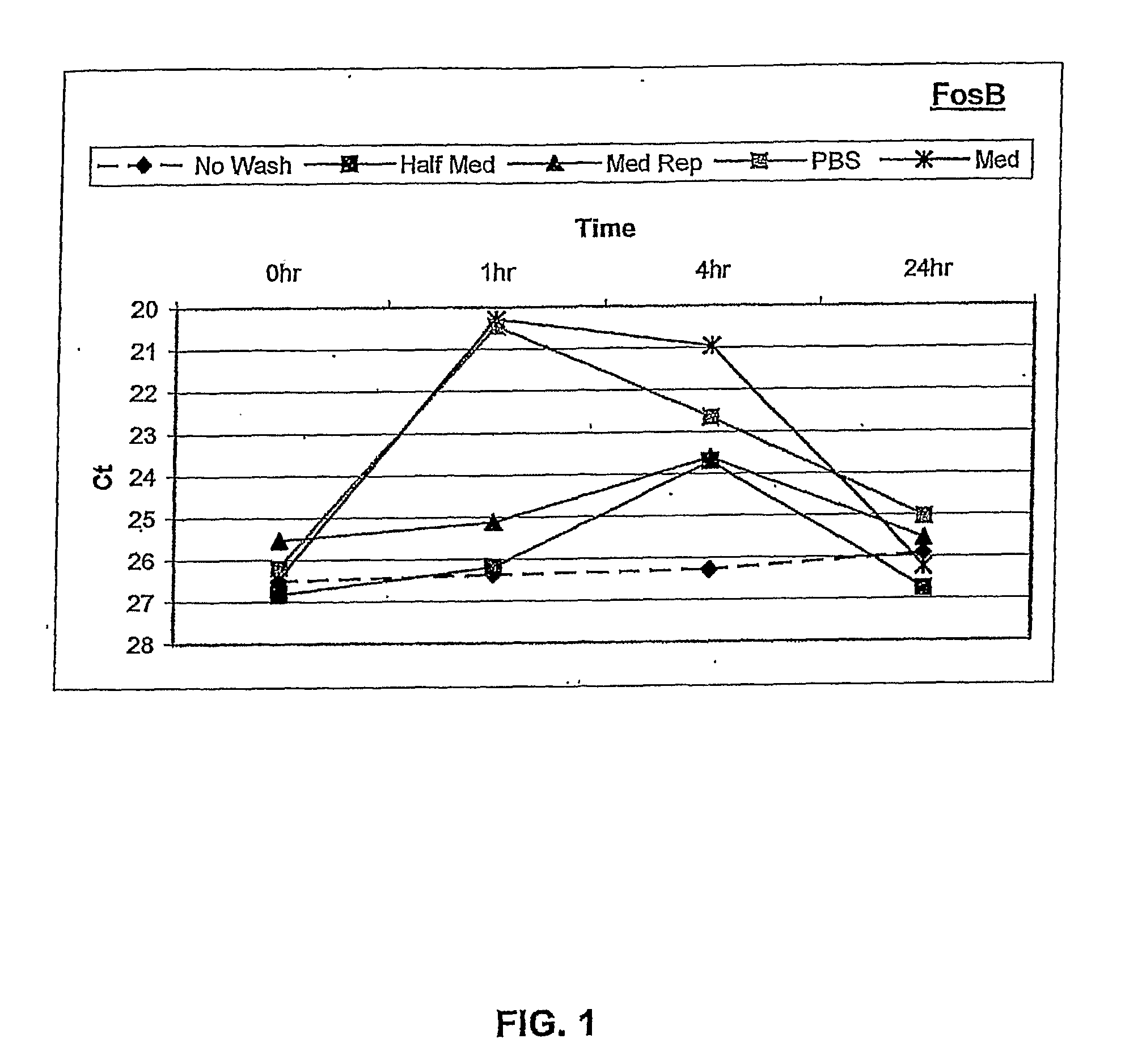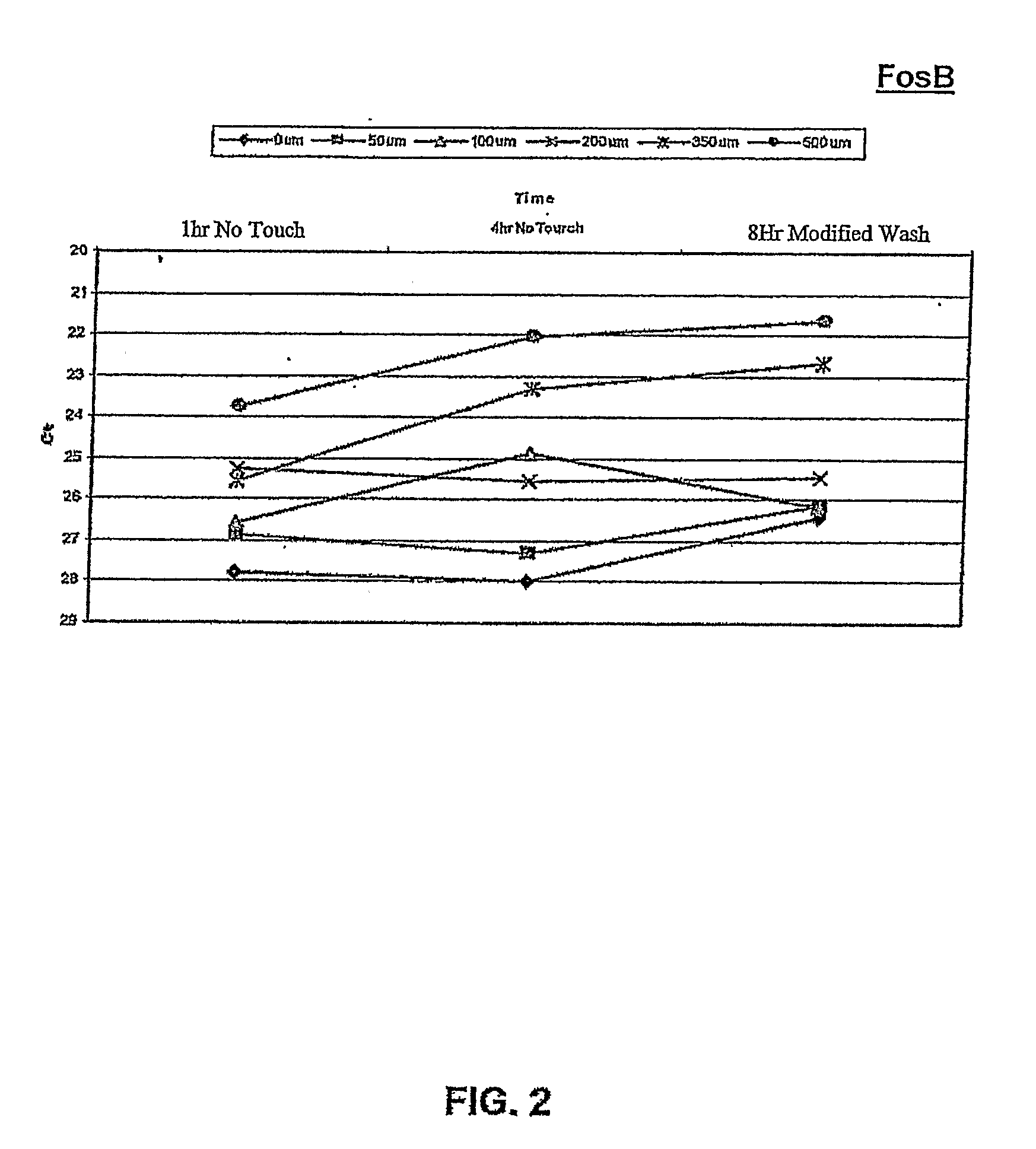Cellular Biomarker Antioxidant Assay and Uses Thereof
a technology of antioxidant assay and cellular biomarker, which is applied in the field of cell-based, can solve the problems of threatening the viability of cells, destroying the function of cells, and in some cases destroying,
- Summary
- Abstract
- Description
- Claims
- Application Information
AI Technical Summary
Benefits of technology
Problems solved by technology
Method used
Image
Examples
example 1
Optimizing Culture Conditions for Demonstrating Quantitative OS-Induced Gene Expression
[0118]In preliminary studies, fluctuations in gene expression were observed in response to the tissue culture protocols used for the cell-based assays. This example describes a systematic analysis to identify the factors responsible for non-specific cellular responses. Major inducing factors are identified and techniques to minimize them in quantitative studies are described.
[0119]Methods:
[0120]Human ARPE-19 cells were seeded into 6-well tissue culture plates and grown to confluence. After reaching confluence, the cells were cultured for three days in defined NR-1 medium to stabilize gene expression. RNA was isolated from the cells at 0, 1, 4, and 24 hours following different rinse conditions. These included: i) no touch control, ii) manual pipette aspiration followed by media replacement with conditioned media, iii) vacuum aspiration followed by PBS rinse, then media replacement with conditioned ...
example 2
Dose-Dependent Responses to Oxidative Stress (OS)
[0127]This example shows that using optimized culture conditions as described in the above Example, accurate quantification of OS-specific changes in gene expression can be achieved using the cell-based assay.
[0128]Methods:
[0129]Assays of oxidative stress as described above with RPE cells were performed using the “no touch” technique, to determine whether OS-specific responses of FosB gene expression occurred during the first 8 hours after induction of stress. In addition, a dose-response study of FosB gene expression was performed to determine whether the degree of OS could be quantified using this molecular response.
[0130]OS-induced transcriptional responses were measured by quantitative RT-PCR (qPCR) following RNA isolation using the “no touch” method at 1 hour and 4 hours after OS, and at 8 hours after OS (H2O2 removed by “Half med” rinse after 1 hour)
[0131]Results:
[0132]Referring to FIG. 2, the data from qPCR showed a significant...
example 3
Expression Profiles of Biomarkers in Cell-Based Assay of Oxidative Stress
[0133]This Example describes effects of culture conditions on expression a several biomarkers, i.e., JunB, EGR-1 and HO-1 in a cell-based assay in accordance with the invention.
[0134]Methods:
[0135]Quantitative JunB gene expression studies were performed by qPCR using the cell-based assay with RPE cells and the “no-touch” and modified rinse conditions as described above.
[0136]Results:
[0137]Referring to FIG. 3, a method-induced increase in JunB transcription was observed at both 1 and 4 hours after subjecting the cultures to OS. More specifically, FIG. 3 shows the effect of tissue culture rinse conditions on JunB gene expression in RPE cells. Rinsing the cells with buffered saline or conditioned media alone, in absence of an exogenous stress-inducing agent, induced JunB expression in these cells. As with FosB, a similar response pattern was seen for JunB in which gene expression increased by 8- to 16-fold 1 hour ...
PUM
| Property | Measurement | Unit |
|---|---|---|
| Magnetic field | aaaaa | aaaaa |
| Current | aaaaa | aaaaa |
| Concentration | aaaaa | aaaaa |
Abstract
Description
Claims
Application Information
 Login to View More
Login to View More - R&D
- Intellectual Property
- Life Sciences
- Materials
- Tech Scout
- Unparalleled Data Quality
- Higher Quality Content
- 60% Fewer Hallucinations
Browse by: Latest US Patents, China's latest patents, Technical Efficacy Thesaurus, Application Domain, Technology Topic, Popular Technical Reports.
© 2025 PatSnap. All rights reserved.Legal|Privacy policy|Modern Slavery Act Transparency Statement|Sitemap|About US| Contact US: help@patsnap.com



